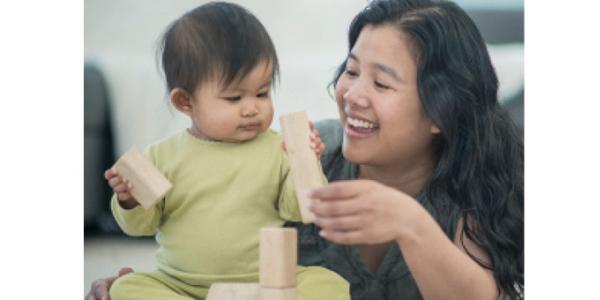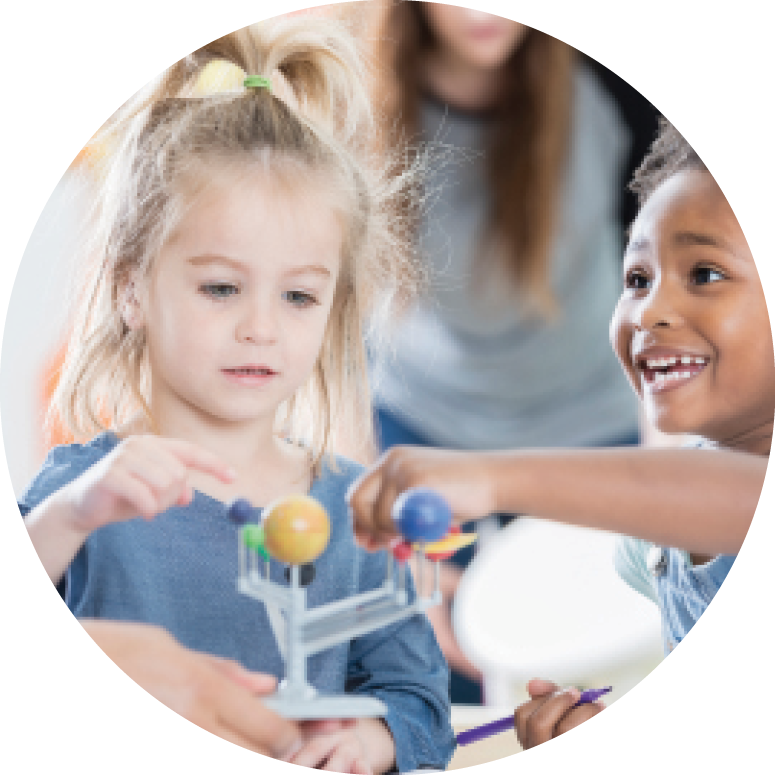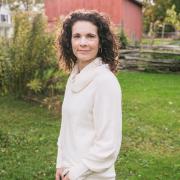Learning from Birth: Ontario’s EarlyON Child and Family Centres

You are here
Ali bounds up the school’s front entrance, his backpack bouncing with each step. Once inside, he rounds a corner, raises his hand in a friendly salute to the secretary, and continues down the hall until he reaches his destination. Only 3 years old and already navigating the school building like an expert! His mother trails behind with his 7-month-old brother. The trio are on their way to the EarlyON Child and Family Centre in their local school. Ali’s family has been attending twice weekly since Ali was a baby.
EarlyON Child and Family Centres are free drop-in centers in Ontario, Canada, for children birth to 6 years of age, along with their parents or other caregivers. The centers embody everything one could hope for in an early years environment—a bright, clean place filled with learning materials and books, elements of nature, displays of children’s artwork, motivational and information posters, and photos of children and their families playing together.
The participants in the centers are as diverse and interesting as the centers themselves and are representative of Canadian society. Walk into any center and you’ll hear a symphony of languages, see a rainbow of colors, and find people of all ages working together to support one another and the children they bring with them each day. And whether the participants are newcomers to Canada, young parents, caregivers to children who are not their own, or people looking for a support system in the community, the commonality they share is their desire for the best for the children in their care, even if they have different starting points in their EarlyON journeys (Gordon 2000).
Although many early childhood programs exist in Ontario to support families and help make the transition to school a success, only EarlyON Child and Family Centres are required to be inside elementary schools. Funded by the Ontario Ministry of Education, each center is led by a facilitator who is a certified and registered early childhood educator employed by the district board of education. Facilitators strive to create developmentally appropriate, rich learning environments for children while supporting and encouraging families to be active participants in the children’s play-based educational experiences. Families can visit these centers regularly (days and times vary by location), as there are no restrictions on attendance.
Each facilitator is responsible for creating and maintaining a learning environment similar to a kindergarten classroom, with a variety of learning centers (e.g., reading nook, dramatic play area, art table, sensory tables); children and their families are encouraged to play together in a space. Story and snack time also occur each day. Research shows that children who regularly attended EarlyON Child and Family Centres four or more times a month before starting school performed better than peers who did not attend, or did not regularly attend, in whole-child development, academics in the primary grades, cooperation, and school engagement (Yau 2009).
Facilitators helped parents understand developmentally appropriate practice and advised parents regarding questions to ask teachers.
Intrigued by these results, Deanna (the first author) spent 10 weeks studying the experiences of families attending the EarlyON Child and Family Centres. Using an ethnographic framework, she collected information in order to obtain as holistic a picture as possible of life in a center. What fascinated her most were the implications of locating the centers in local elementary schools run by school-board-employed early childhood educators, and how this impacted participant interactions and families’ engagement in their children’s future educational experiences.
Facilitator as school ambassador to families
The prevalent theme in the qualitative data was the importance of the role the facilitators played in the centers—not only in creating and cultivating safe and supportive learning environments for children, but in welcoming, embracing, and supporting the adults and extending the intricate relationships the facilitators had with them. One mom said, “Ms. Tina is a role model who is looked up to in many positive ways. Her guidance and support—and just her being who she is—bring me to the center each day.”
The majority of respondents indicated that the early childhood education facilitators were the main reason they attended EarlyON Child and Family Centres, which is in keeping with previous research findings that “no significant learning occurs without a significant relationship” (Comer 1995). This is especially important because when parents feel supported, they are more likely to continue with the learning in their home environments (Raikes & Pope Edwards 2009).
Although each center followed the same Ministry for Children and Youth Services guidelines, Early Learning for Every Child Today (ELECT) (Best Start Expert Panel 2007), facilitators personalized their approaches and strategies based on the interests, strengths, and needs of the population that visited each day. One role that I noticed each facilitator playing was school ambassador to families. One caregiver stated,
I love this place. No matter who you are or where you come from, you fit in. That’s what’s so great—I can talk to anybody and learn from other parents. It doesn’t matter what country you are from, what clothes you wear, or what language you speak.
Partnerships between families and their communities strengthen the abilities of early childhood centers to meet the needs of young children. When these partnerships are respectful of a family’s structure, culture, values, language, and knowledge, they support parents’ efforts for their children’s optimal development in all domains. When families or other caregivers are actively involved in early childhood settings, opportunities for children’s learning increase as the caregivers provide both learning and care (Weiss, Caspe, & Lopez 2006).
Parents were naturally woven into the tapestry of each school community due to an EarlyON Child and Family Centre being in the school building. “In an increasingly stressful and divided society, [schools] can open the doors to social inclusion and provide a sense of belonging for all children and families” (Pascal 2009, 17). The centers provided multiple opportunities for families to become comfortable spending time together and forming relationships with teaching staff and administration. In their role as school ambassadors, facilitators were able to help empower parents with knowledge and confidence, positively affecting their interactions with others in the schools and aiding them in advocating with school staff for their children’s futures in a more positive, informed manner. According to one parent,
[The facilitator] helps parents understand how they can approach a teacher—some [parents] who may not have had good experiences at school now have a better understanding of how to approach administration or [how] to go to a teacher to express their concerns rather than going to the neighborhood and complaining.
As well-prepared educators and school board employees, facilitators helped parents understand the curriculum and developmentally appropriate practice, acted as sounding boards when parents experienced frustrations, advised parents regarding questions to ask teachers and administrators about concerns, acted as liaisons to help parents speak with school staff, provided steps for following up, and cleared up misconceptions parents had about school in general. EarlyON Child and Family Centres provided parents multiple entry points for (re)connecting with the institution of education, regardless of whether or not their previous experiences had been positive. According to one administrator,
We’ve seen a tremendous increase in school Parent Council representation and in parents being involved in some of the after-school activities or some of the events that happen during the day. . . . We’ve seen the impact in the work the staff is doing in trying to bridge that gap between the community’s fears of school and seeing what it’s truly about and bringing them into the building. The parents attending the center see this building every day and see what is happening in this building. We value them. They are half the battle in their child’s education. Their input and how they value education is critical.
Often it is our own childhood baggage and bias that influence how we interpret and interact with the world around us (Ramirez & Soto-Hinman 2009). The location of centers in schools and the encouragement from facilitators as ambassadors welcoming families provided parents with a chance to connect with a school in a positive manner. This may have helped heal emotional wounds from previous experiences, as parents reported reduced fear of school staff and expectations and renewed interest in pursuing the best possible education for their children.
In schools with EarlyON Child and Family Centres, interest in serving on Parent Council increased and attendance at school functions improved, as parents indicated overwhelmingly in qualitative data that they felt more comfortable in a school environment since attending the centers. Often one person attending inspired another to come along, connecting parents to one another as they realized even greater commonalities. This positive energy benefited not only their young children who would be starting kindergarten but also older siblings who were already students in the building. According to one administrator,
The center doesn’t just affect preschool children, it also affects children currently in school. It helps parents not be afraid of the school setting because a lot of our families have not necessarily experienced success with the school system. And so, school is a scary place. School is not a place that they’ve been successful in and [the center] helps families feel like they belong.
Educators connecting with families
School staff also appeared to benefit from families’ participation in the centers. In every center I visited, I was told stories by teachers who felt it was important to connect with the center in some capacity—visiting regularly to share special talents, such as playing an instrument, or engaging in informal conversations with parents over coffee. Because facilitators are recognized members of the school staff, they are able to cultivate relationships with teachers and encourage this type of interaction with the center. One teacher noted that
this is the side of teaching that I fell in love with a long time ago. Spending time [in the center] helps me reconnect with that. I also think that . . . I am establishing a rapport with kids and their parents that could carry into the future if they end up in my class. I got involved with the center because I see its value and its place in the community.
When teachers and families work together to support student learning, children achieve more in school, stay in school longer, and appear to enjoy school more (Cole-Henderson 2000).
 School administrators who visited the centers regularly also reported improved relations with families. Interviews revealed that principals greatly valued the relationships between the centers and schools; they felt the centers enhanced the schools’ reputations in the neighborhoods. Center families were invited to daytime school events, like assemblies and special event days (e.g., guest speakers, read-a-thons, play days), which promoted a positive climate in the community.
School administrators who visited the centers regularly also reported improved relations with families. Interviews revealed that principals greatly valued the relationships between the centers and schools; they felt the centers enhanced the schools’ reputations in the neighborhoods. Center families were invited to daytime school events, like assemblies and special event days (e.g., guest speakers, read-a-thons, play days), which promoted a positive climate in the community.
Principals felt it was important for them to make regular visits to their schools’ EarlyON Child and Family Centres and spend time interacting with families (e.g., reading books with children, conversing with parents, attending special center events) in efforts to portray themselves as partners in education (instead of school disciplinarians) and school offices as safe and supportive places to visit. I often observed children being invited by the facilitator to share their artifacts of learning (e.g., drawing, writing, painting) with the office staff. These creations would then be displayed alongside photos of the children engaged in the center so that visitors could appreciate the rich learning and engagement occurring there.
These early experiences were instrumental in helping parents conceptualize what learning through play looks like.
Administrators felt that
- The EarlyON Child and Family Centre and the facilitator helped prepare children and their families for successful school entry, which made the start of the school year easier for everyone
- The facilitator helped school staff with kindergarten intake by encouraging early intervention (usually through community supports) for children who had exhibited needs while involved in the center; the facilitator also participated in developing class lists and hosting open houses in preparation for the beginning of the school year
- It was important to encourage all school staff to be as active and involved in the center as possible (e.g., bringing their students down to read to or perform a presentation for center families, sharing resources and ideas with the facilitator, including the facilitator in the school’s professional development)
Collaborating with kindergarten
Kindergarten teachers were especially grateful for EarlyON Child and Family Centres and for their shared relationships with the facilitators. Facilitators and teachers attended school staff meetings and professional development opportunities together and shared resources and teaching strategies as they worked to implement the then-new Ontario Ministry guidelines for play-based emergent curriculum (Ontario Ministry of Education 2010). This shared vision for the youngest learners resulted in the use of a consistent teaching approach throughout the centers and kindergartens. According to one principal, “The center encourages parents to sing songs to children and play with children, and to recognize that the play is the work.”
These early experiences with developmentally appropriate practice were instrumental in helping parents conceptualize what learning through play looks like. They could apply this new knowledge to their understandings of kindergarten when their children began school.

Parents also reported appreciation for the relationships they developed with kindergarten staff before their children began school. “I like knowing who my child’s teacher will be and forming a relationship with her before my child even sets foot in the kindergarten classroom,” one mom shared in an interview. Kindergarten teachers often stopped by the EarlyON Child and Family Centres to mingle with families and share experiences from their current classrooms (e.g., kindergarten students singing songs in the center). This gave center children familiar names and faces to look forward to as their future kindergarten teachers.
Parents also indicated that they
- Appreciated that the facilitator helped to make the initial connection between their family and the kindergarten teachers, often introducing them casually in the EarlyON Child and Family Centre
- Liked being able to bring their children to the kindergarten room so they could visit during playtime in the year before they were to start school
- Appreciated knowing the school board’s philosophy for early childhood education (e.g., play-based learning) as supported in both the centers and the kindergarten programs
- Were glad to learn tips for helping to prepare their child for successful entry into the school
- Felt comfortable meeting some of the other potential families and children who might eventually attend the same kindergarten program as their own children
According to one caregiver, “We have learned that school is a good place to be. It is a very welcoming center, and the entire kindergarten staff is also on board with what is happening in the center and how it will promote a positive school experience for all children.”
Early identification of children’s needs and smooth transitions to school
Facilitators helped ensure as smooth a start to kindergarten as possible by working with parents on the early identification of their children’s needs, many of which might not have been recognized or supported without families’ involvement in an EarlyON Child and Family Centre. A family-centered approach to early intervention that treats families with dignity and respect and provides the necessary resources is essential to successful early childhood development (Bruder 2010). As school board employees, facilitators are able to connect families in centers with key resources, including special education teachers, speech and language pathologists, social workers, and psychologists.
In each center I visited, I spoke with numerous families who were thankful for the experienced eye of their facilitator, who openly and honestly talked with them about something observable in their child’s behavior that indicated a developmental need. Acting as a liaison, each facilitator helped families contact appropriate community agencies to receive support and guidance regarding their child’s need. When early interventions were provided, information was shared with the school. Then, as school started, teachers were able to take children’s needs into consideration and be well prepared for the first few days of school (e.g., informing class lists, providing initial observations of children, and allocating support staff).
Interviews with parents revealed widespread agreement that the transition to school was much easier for children attending centers:
My child had no problems at all attending the kindergarten open house this past winter, and it’s because she’s been at the center her whole life. Normally she’s very shy and quiet, but the center has helped her overcome this.
My son is right at home in the kindergarten classroom because it’s just another classroom in the school to him—just like the center.
The center has helped prepare my daughter for school by teaching her how to deal with other children—how to work together, how to express herself when upset with a friend, how to play and share and take turns.
My son is more independent and is more comfortable with other children. The transition into school has gone so smoothly, and I credit this to coming to the center. We feel comfortable and my kids feel loved and accepted.
Teachers reported similar benefits—especially teachers who were interested in implementing an emergent curriculum based on children’s expressed interests and needs. In many classrooms, teachers used what they had learned from the facilitator about children’s strengths and interests (e.g., trains, cars, dolls, painting) to determine activities for the first few days of school. Knowing what children liked helped make the first school days comforting and enjoyable for the children.
Bringing learning home
A large part of the EarlyON Child and Family Centre mandate is to help families understand how to extend the learning happening in the centers into their lives at home. “The family is the most basic and enduring of the social institutions, next to the institution of education, and society counts on parents to serve as the first instructors of its children” (Shearin 2007, 32). According to one father, “This is an excellent program. Every parent would benefit from it. I feel better equipped and encouraged to be the best parent I can be to my children.” Songs and finger plays were the most popular home-extension activities indicated by parents in interviews, with borrowing books and accessing parenting information and learning materials from the centers being the second most popular extension.
Part of the success in transference of literacy and numeracy activities into the home environment might be due to facilitators’ demonstrations of learning activities that were cost effective and easy to gather and make (e.g., puzzles made from cut-up cereal boxes, stamping paint with kitchen sponges, playing with empty jugs at the water table). Repeated practice with similar activities helps children feel even more prepared to enter school with confidence; the activities also help adults support children’s language and vocabulary development in a natural environment (Kaiser & Roberts 2011).
Since researching EarlyON Child and Family Centres, I too have become a center parent. The highlight of my older son’s week is when we get to visit our local school so he can explore the diverse learning materials in the center. I love seeing the budding friendships he is making, and I take comfort in the fact that these same children will most likely be in his kindergarten class next year. And although his transition to kindergarten will be bittersweet for me, I know that he has been well prepared as a result of the time he has spent learning in our local EarlyON Child and Family Centre.
—Deanna Pecaski McLennan
References
Best Start Expert Panel on Early Learning. 2007. Early Learning for Every Child Today: A Framework for Ontario Early Childhood Settings. www.edu.gov.on.ca/childcare/oelf/continuum/continuum.pdf.
Bruder, M.B. 2010. “Early Childhood Intervention: A Promise to Children and Families for Their Future.” Exceptional Children 76 (3): 339–55.
Cole-Henderson, B. 2000. “Organizational Characteristics of Schools That Successfully Serve Low-Income Urban African American Students.” Journal of Education for Students Placed at Risk 5 (1–2): 77–91.
Comer, J. 1995. Lecture given at Education Service center, Region IV, Houston, TX.
Gordon, M. 2000. “Home Is Where the Start Is: Parenting and Family Literacy Centres of the Toronto District School Board.” Education Canada 39 (3): 44–47.
Kaiser, A.P., & M.Y. Roberts. 2011. “Advances in Early Communication and Language Intervention.” Journal of Early Intervention 33 (4): 298–309.
Ontario Ministry of Education. 2010. Parenting and Family Literacy Centres: Resource Binder. Toronto, ON: Queen’s Printer for Ontario.
Pascal, C.E. 2009. With Our Best Future in Mind: Implementing Early Learning in Ontario. Toronto, ON: Queen’s Printer for Ontario. https://wbe-education.ca/wp-content/uploads/2014/07/early_learning_repor....
Raikes, H.H., & C.P. Edwards. 2009. “Staying in Step: Supporting Relationships with Families.” Young Children 64 (5): 50–55.
Ramirez, A.Y., & I. Soto-Hinman. 2009. “A Place for All Families.” Educational Leadership 66 (7): 79–82.
Shearin, S.A. 2007. “Kinship Care Placement and Children’s Academic Performance.” Journal of Health & Social Policy 22 (3–4): 31–43.
Weiss, H.B., M. Caspe, & M.E. Lopez. 2006. “Family Involvement in Early Childhood Education.” (Research brief No. 1, Family Involvement Makes a Difference Series.) Cambridge, MA: Harvard Family Research Project.
Yau, M. 2009. Parenting and Family Literacy Centres: Making a Difference beyond Early School Readiness. Toronto, ON: Toronto District School Board. www.tdsb.on.ca/Portals/research/docs/reports/PFLC%20Phase3FinalV2.pdf.
Photographs: © Getty Images
Deanna Pecaski McLennan, PhD, is a kindergarten educator and author in Windsor, Ontario, Canada. She loves exploring mathematics through a play-, inquiry-based approach. She enjoys sharing her classroom practice and connecting with others using social media. @McLennan1977

Clara Howitt, PhD, is a superintendent of education with the Greater Essex County District School Board in Windsor, Ontario. She is responsible for curriculum and programming from early childhood to grade 12.